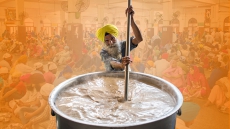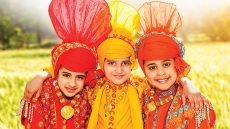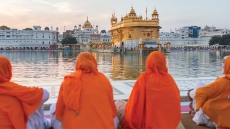An embodiment of spirit, selflessness and service, Vaisakhi is a true celebration of community.
In the multicultural realm of today’s global fabric, the colours of Vaisakhi stand as a testament to both the sanctity of its historical significance and evolution as a communal festivity. Vaisakhi takes place in the month of Vaisakh, according to the Sikh/Punjabi Calendar, and marks the beginning of the Sikh New Year, rooted in multiple facets of its history. From a religious standpoint, Vaisakhi celebrates the founding of the Khalsa. To this day, the city of Anandpur Sahib is laced with a multitude of festivities, symbolizing courage, sacrifice and equality. In light of the religious sentiments, there are congregations and parades around the world, where values of spirituality are embedded into the coming generations.

Apart from the socio-cultural meaning of the Jallianwala Bagh incident, Vaisakhi also carries the essence of a harvest festival. As the winter crops are harvested, farmers rejoice the fruits of the year-long labour. A treat to the five senses, Vaisakhi fairs are still widely held, featuring energetic Bhangra and Giddha dancers who reflect the rich Punjabi culture through longstanding folk dances. In fact, upon careful observation, one sees that the movements of Bhangra articulate and imitate farming actions such as sowing, harvesting, reaping and gathering. Adorning the self with beautiful jewellery alongside traditional clothing instills a sense of pride.

While Vaisakhi has initially originated in Punjab, the migration of South Asian communities into other parts of the globe has brought many contemporary variations and meanings to the festival. Covered by mainstream media in many countries, Vaisakhi is no longer just exclusive to a certain community. Regardless of ethnic, cultural, or national background, friends and family await the celebrations that accompany Vaisakhi. Contemporary studies have also increasingly incorporated education surrounding the festival into curriculums. In the past decade, many public schools have begun to hold Vaisakhi celebrations, which plays the role of bringing awareness in other cultures who may not be as informed.

Vaisakhi, as a result, is also a medium of expression for various artists and activists. Be it through art or advertisement, there are various platforms available to spread word about important causes. The meaning of Vaisakhi, therefore, transcends just the historical significance; as time passes, these cultural meanings are renewed and revived. For many, Vaisakhi is a time to give back to the company – be it through local businesses sponsoring events and activities or personal contributions in other forms. Endless forms of giving have emerged as the concept of seva is not limited to solely a physical institution when it comes to Vaisakhi.
While the festival continues to take shape, it is of utmost importance to preserve the purity of its beginnings. As we welcome the new season with open arms, Vaisakhi symbolizes the presence of hope and carries the message of being open to what the universe has to offer. Combining the past, present and future branches of Vaisakhi, the festival can be seen both as the pinnacle of Punjabi culture and a catalyst of multiculturalism and inclusiveness.

ABOUT THE AUTHOR:
Naina Grewal is a youth radio show host on Red FM and is pursuing a Business and Communication Joint Major at SFU as a student on the President’s and Dean’s Honour Roll. Recently recognized as Surrey Board of Trade’s Top 25 Under 25, Naina is an engaged community volunteer, passionate about creating dialogue, and stirring youth involvement.





